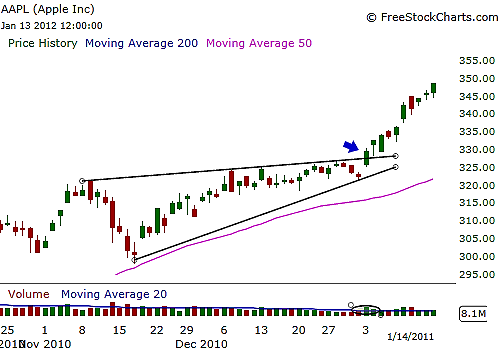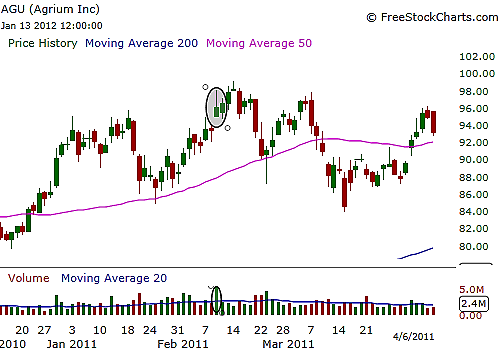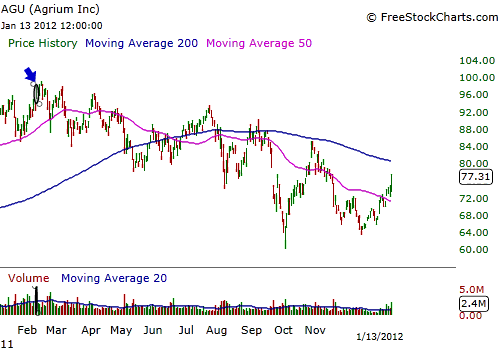
HOT TOPICS LIST
- MACD
- Fibonacci
- RSI
- Gann
- ADXR
- Stochastics
- Volume
- Triangles
- Futures
- Cycles
- Volatility
- ZIGZAG
- MESA
- Retracement
- Aroon
INDICATORS LIST
LIST OF TOPICS
PRINT THIS ARTICLE
by Billy Williams
Technicians use price action to dictate their trading decisions, but that is a waste of time if you don't understand how to use volume, the fuel for price movement, to trade well.
Position: Hold
Billy Williams
Billy Williams has been trading the markets for 27 years, specializing in momentum trading with stocks and options.
PRINT THIS ARTICLE
VOLUME
Four Types Of Trading Volume To Use For Higher Gains
01/18/12 02:03:57 PMby Billy Williams
Technicians use price action to dictate their trading decisions, but that is a waste of time if you don't understand how to use volume, the fuel for price movement, to trade well.
Position: Hold
| In trading, it can be argued that price action is the most critical determinant for buying and selling a stock. Traders who rely on price to determine their trading decisions are commonly referred to as "discretionary" traders, or technicians. But the fact is that technicians who achieve a level of skill can make independent decisions on their own without turning into a mindless drone who responds to the bells and whistles of a mechanical decision like Pavlov's dog. However, the rub for technical trading based on price alone is not enough to make informed decisions, since it is only one side of the coin when speculating in the stock market. Volume is the other side of the coin, because it is the very fuel that drives the price of a stock. Since price action moves between periods of expansion and contraction, then volume is the key factor that reveals which side -- bulls or bears -- have control of the stock's price movement. See Figure 1. |

|
| FIGURE 1: AAPL. In early 2011, Apple Inc. formed a rising bullish triangle over several weeks until breaking out on January 3, 2011, on higher volume and resuming its bullish run. |
| Graphic provided by: www.freestockcharts.com. |
| |
| Volume helps the technician determine when price is under accumulation or distribution. If a stock is under accumulation, it will reveal it by climbing in share price, as buying volume is on the rise as the bulls take control of the stock's trend. Likewise, if a stock is under distribution, the price of the stock will decline as selling volume increases, based on the bears taking control of trend as well. In addition, volume acts as rocket fuel, which can act as a catalyst for a new trend to emerge or an established trend to suddenly come to a halt. See Figure 2. |

|
| FIGURE 2: AGU. AGU experienced a huge volume spike on February 9, 2011, as buyers tried to force the stock higher. This was a warning signal that price and volume was exhausting itself and a trend reversal was under way. |
| Graphic provided by: www.freestockcharts.com. |
| |
| When this phenomenon occurs, volume can be classified as either "breakout volume" or "exhaustive volume." In breakout volume, price is usually in a period of contraction where it is trading between support and resistance until price begins to emerge from that contracted price range while accompanied on greater trading volume. Like dynamite that sits inert with great potential power, that power is realized by an external catalyst such as a match where its explosive force is allowed to materialize, and so it is with price and volume. Volume acts as the catalyst to unlock the potential power of an inert trend and, once it is unleashed, can emerge to realize its full potential. See Figure 3. |

|
| FIGURE 3: AGU. In the days and weeks that followed, AGU couldn't muster the support needed from the bulls to continue its uptrend and began to form a series of lower highs and lower lows as the stock began to decline. |
| Graphic provided by: www.freestockcharts.com. |
| |
| With exhaustive volume, a stock's price may have experienced a strong move in its price, but now the trend may have run its course, due to investor fears of overvaluation or hopes of undervaluation. In either scenario, exhaustive volume is marked by an abnormal spike of buying volume near the stock's peak or selling volume at its price low. This abnormal volume spike is indicative of the last mass buying and/or selling on the part of traders in a desperate attempt to drive the stock higher or lower, depending on the context of the market at the time. Typically, the professional speculators use this as an opportunity to cash out as the amateurs rush under the pretense of capitalizing on a move that is already done and over with. |
| Price and volume have a unique relationship that must be taken into consideration when looking to make a trade in any stock or security. If both are moving in harmony with one another, then it will be reflected in the price of the stock itself. If they begin moving away from each other or begin to be more volatile than past trading accounts, then the underlying dynamic of price movement could be affected, allowing you to take the necessary steps to protect your capital while preparing to profitably exploit whatever follows. |
Billy Williams has been trading the markets for 27 years, specializing in momentum trading with stocks and options.
| Company: | StockOptionSystem.com |
| E-mail address: | stockoptionsystem.com@gmail.com |
Traders' Resource Links | |
| StockOptionSystem.com has not added any product or service information to TRADERS' RESOURCE. | |
Click here for more information about our publications!
Comments
Date: 12/10/14Rank: 5Comment:

|

Request Information From Our Sponsors
- StockCharts.com, Inc.
- Candle Patterns
- Candlestick Charting Explained
- Intermarket Technical Analysis
- John Murphy on Chart Analysis
- John Murphy's Chart Pattern Recognition
- John Murphy's Market Message
- MurphyExplainsMarketAnalysis-Intermarket Analysis
- MurphyExplainsMarketAnalysis-Visual Analysis
- StockCharts.com
- Technical Analysis of the Financial Markets
- The Visual Investor
- VectorVest, Inc.
- Executive Premier Workshop
- One-Day Options Course
- OptionsPro
- Retirement Income Workshop
- Sure-Fire Trading Systems (VectorVest, Inc.)
- Trading as a Business Workshop
- VectorVest 7 EOD
- VectorVest 7 RealTime/IntraDay
- VectorVest AutoTester
- VectorVest Educational Services
- VectorVest OnLine
- VectorVest Options Analyzer
- VectorVest ProGraphics v6.0
- VectorVest ProTrader 7
- VectorVest RealTime Derby Tool
- VectorVest Simulator
- VectorVest Variator
- VectorVest Watchdog
